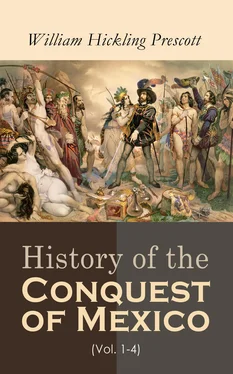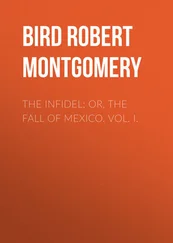Table of Contents
MEXICAN MYTHOLOGY—THE SACERDOTAL ORDER—THE TEMPLES—HUMAN SACRIFICES
THE civil polity of the Aztecs is so closely blended with their religion that without understanding the latter it is impossible to form correct ideas of their government or their social institutions. I shall pass over, for the present, some remarkable traditions, bearing a singular resemblance to those found in the Scriptures, and endeavor to give a brief sketch of their mythology and their careful provisions for maintaining a national worship.
Mythology may be regarded as the poetry of religion, or rather as the poetic development of the religious principle in a primitive age. It is the effort of untutored man to explain the mysteries of existence, and the secret agencies by which the operations of nature are conducted. Although the growth of similar conditions of society, its character must vary with that of the rude tribes in which it originates; and the ferocious Goth, quaffing mead from the skulls of his slaughtered enemies, must have a very different mythology from that of the effeminate native of Hispaniola, loitering away his hours in idle pastimes, under the shadow of his bananas.
At a later and more refined period, we sometimes find these primitive legends combined into a regular system under the hands of the poet, and the rude outline moulded into forms of ideal beauty, which are the objects of adoration in a credulous age, and the delight of all succeeding ones. Such were the beautiful inventions of Hesiod and Homer, “who,” says the Father of History, “created the theogony of the Greeks;” an assertion not to be taken too literally, since it is hardly possible that any man should create a religious system for his nation. [97]They only filled up the shadowy outlines of tradition with the bright touches of their own imaginations, until they had clothed them in beauty which kindled the imaginations of others. The power of the poet, indeed, may be felt in a similar way in a much riper period of society. To say nothing of the “Divina Commedia,” who is there that rises from the perusal of “Paradise Lost” without feeling his own conceptions of the angelic hierarchy quickened by those of the inspired artist, and a new and sensible form, as it were, given to images which had before floated dim and undefined before him?
The last-mentioned period is succeeded by that of philosophy; which, disclaiming alike the legends of the primitive age and the poetical embellishments of the succeeding one, seeks to shelter itself from the charge of impiety by giving an allegorical interpretation to the popular mythology, and thus to reconcile the latter with the genuine deductions of science.
The Mexican religion had emerged from the first of the schools we have been considering, and, although little affected by poetical influences, had received a peculiar complexion from the priests, who had digested as thorough and burdensome a ceremonial as ever existed in any nation. They had, moreover, thrown the veil of allegory over early tradition, and invested their deities with attributes savoring much more of the grotesque conceptions of the Eastern nations in the Old World, than of the lighter fictions of Greek mythology, in which the features of humanity, however exaggerated, were never wholly abandoned. [98]
In contemplating the religious system of the Aztecs, one is struck with its apparent incongruity, as if some portion of it had emanated from a comparatively refined people, open to gentle influences, while the rest breathes a spirit of unmitigated ferocity. It naturally suggests the idea of two distinct sources, and authorizes the belief that the Aztecs had inherited from their predecessors a milder faith, on which was afterwards engrafted their own mythology. The latter soon became dominant, and gave its dark coloring to the creeds of the conquered nations,—which the Mexicans, like the ancient Romans, seem willingly to have incorporated into their own,—until the same funereal superstition settled over the farthest borders of Anahuac.
The Aztecs recognized the existence of a supreme Creator and Lord of the universe. They addressed him, in their prayers, as “the God by whom we live,” “omnipresent, that knoweth all thoughts, and giveth all gifts,” “without whom man is as nothing,” “invisible, incorporeal, one God, of perfect perfection and purity,” “under whose wings we find repose and a sure defence.” These sublime attributes infer no inadequate conception of the true God. But the idea of unity—of a being with whom volition is action, who has no need of inferior ministers to execute his purposes—was too simple, or too vast, for their understandings; and they sought relief, as usual, in a plurality of deities, who presided over the elements, the changes of the seasons, and the various occupations of man. [99]Of these, there were thirteen principal deities, and more than two hundred inferior; to each of whom some special day or appropriate festival was consecrated. [100]
At the head of all stood the terrible Huitzilopochtli, the Mexican Mars; although it is doing injustice to the heroic war-god of antiquity to identify him with this sanguinary monster. This was the patron deity of the nation. His fantastic image was loaded with costly ornaments. His temples were the most stately and august of the public edifices; and his altars reeked with the blood of human hecatombs in every city of the empire. Disastrous indeed must have been the influence of such a superstition on the character of the people. [101]
A far more interesting personage in their mythology was Quetzalcoatl, god of the air, a divinity who, during his residence on earth, instructed the natives in the use of metals, in agriculture, and in the arts of government. He was one of those benefactors of their species, doubtless, who have been deified by the gratitude of posterity. Under him, the earth teemed with fruits and flowers, without the pains of culture. An ear of Indian corn was as much as a single man could carry. The cotton, as it grew, took, of its own accord, the rich dyes of human art. The air was filled with intoxicating perfumes and the sweet melody of birds. In short, these were the halcyon days, which find a place in the mythic systems of so many nations in the Old World. It was the golden age of Anahuac. [102]
From some cause, not explained, Quetzalcoatl incurred the wrath of one of the principal gods, and was compelled to abandon the country. On his way he stopped at the city of Cholula, where a temple was dedicated to his worship, the massy ruins of which still form one of the interesting relics of antiquity in Mexico. When he reached the shores of the Mexican Gulf, he took leave of his followers, promising that he and his descendants would revisit them hereafter, and then, entering his wizard skiff, made of serpents’ skins, embarked on the great ocean for the fabled land of Tlapallan. He was said to have been tall in stature, with a white skin, long, dark hair, and a flowing beard. The Mexicans looked confidently to the return of the benevolent deity; and this remarkable tradition, deeply cherished in their hearts, prepared the way, as we shall see hereafter, for the future success of the Spaniards. [103]
We have not space for further details respecting the Mexican divinities, the attributes of many of whom were carefully defined, as they descended, in regular gradation, to the penates or household gods, whose little images were to be found in the humblest dwelling.
The Aztecs felt the curiosity, common to man in almost every stage of civilization, to lift the veil which covers the mysterious past and the more awful future. They sought relief, like the nations of the Old Continent, from the oppressive idea of eternity, by breaking it up into distinct cycles, or periods of time, each of several thousand years’ duration. There were four of these cycles, and at the end of each, by the agency of one of the elements, the human family was swept from the earth, and the sun blotted out from the heavens, to be again rekindled. [104]
Читать дальше












